Category: Entry Point into a Topic
Repo: GitHub - markjrieke/rViews: Repo for R-Views article/submission
Using R for business often involves generating recurring reports that are emailed to stakeholders. While R scripts take the legwork out of creating the report, there is still quite a bit of labor involved in rerunning the script and sending out an email with the report attached. Third party automation services, like GitHub Actions, can run the R script regularly, but companies working with sensitive data may require that everything stays within the existing infrastructure. Many companies use Outlook as the email platform and although there is an R package for sending email, mailR, companies with software security that errs on the side of caution may not work well with the package. Analysts, therefore, may find themselves in a unique scenario requiring localized automation of report building and emailing via Outlook. The solution? Convincing R, VBA, and Window’s Task Scheduler to work together to meet your automation needs.
In this article, we’ll look at three basic workflows:
- Generating a report with R
- Automatically running a script with the Task Scheduler
- Automatically sending emails via Outlook with VBA
This article is heavily informed by Sean Carney's article on running scripts with the Task Scheduler and Shirly Zhang's article on scheduling emails with VBA. This article merges the two concepts and points out additional stumbling blocks, but the original articles are well worth viewing.
Generating a Report with R
Suppose we want to create a .csv file containing a weekly summary of the daily new COVID cases in Texas. Our script to generate the report may look something like this:
library(dplyr)
library(readr)
# set working directory
setwd("C:/path/to/your/directory")
# read in data
nyt_covid <- read_csv("https://raw.githubusercontent.com/nytimes/covid-19-data/master/us-states.csv")
# get texas' daily new cases in the past week
nyt_covid <-
nyt_covid %>%
group_by(state) %>%
mutate(new_cases = cases - lag(cases),
new_deaths = deaths - lag(deaths)) %>%
filter(date >= Sys.Date() - 7,
state == "Texas")
# save file
nyt_covid %>%
write_csv("new_cases_tx.csv")
It may seem out out of place, but we need to explicitly set the working directory of the project within the script itself. When the Task Scheduler executes this script, it does so out of a different directory, so we need to tell R to change the working directory.
Running Scripts with the Task Scheduler
Windows' Task Scheduler is an OS level job scheduler that, as the name suggests, completes tasks based on "triggers" (in this case, we're using the system time as a trigger, but other options are available in the scheduler). To setup a task that runs the COVID script weekly, follow these instructions:
1. Open the Task Scheduler and select "Create Basic Task"
2. Give your task a useful name and description
3. Select when the recurring task will run
4. Select "Start a program" as the task action
Later on, we'll use VBA to automatically send emails to avoid any deprecation issues with the "Send an e-mail" function in the scheduler.
5. Enter the path to Rscript.exe into the program field and the path to your script into the argument field
This is where we tell the Task Scheduler to use R! Rscript.exe should be saved under the R\R-version-you-have-installed\bin folder. You can likely find the R folder under C:\Program Files\ or C:\Program Files (x86)\. This informs your computer to use R to run the script at the path in the argument.
There are a few caveats worth noting:
- Unlike R, Windows uses back slashes in the folder path; be sure the path contains
\and not/! - The Task Scheduler can't handle spaces in folder path names - if any of the folders in the path to
Rscript.exeor your report script contain spaces, be sure to encapsulate with quotations! For example,C:\Folder Path with Spaces\COVID_script.Rwill fail, but"C:\Folder Path with Spaces\COVID_script.R"will run.
6. Click Finish
Viola! Your R script is now scheduled to run on a recurring basis. You can test that the task is setup correctly by highlighting the task and selecting "Run" in the lower right corner of the scheduler window.
Automating Emails with VBA
Outlook, unfortunately, doesn't have a built-in method for sending recurring emails. With a bit of VBA, however, we can get around this issue. VBA (or, Visual Basic for Applications) is Microsoft's event-driven programming language that runs within each application. To automatically send emails on a recurring basis, we'll setup a recurring appointment that will serve as the event causing emails to send. Then, we'll write a macro (VBA's equivalent to an R script) that will send an email every time a reminder for this appointment appears.
1. Create a new recurring appointment
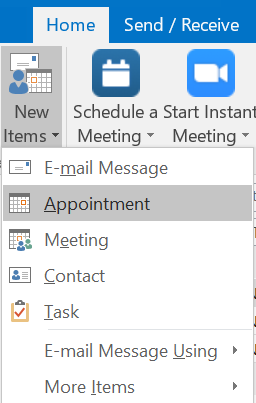
In this case, we'll use several fields very specifically to be picked up by the macro:
- The subject of the appointment will become the subject of the recurring email.
- Add any recipients to the Location field. If sending to multiple recipients, separate each with a
;(e.g.,recipient1@email.com;recipient2@email.com) - Add the folder path for the report to the appointment body.
Be sure to set this appointment for after the script is scheduled to run via the Task Scheduler!
Finally, be sure that there is a reminder set - the reminder notification is what will actually trigger the macro to run.
2. Assign the appointment to a new category for sending automated emails
3. Add the Developer tab to Outlook's ribbon
Outlook Options can be found under File > Options.
4. Enable Macros

It's recommended to select "Notifications for all macros," rather than "Enable all macros." This will require that macros are re-enabled every time Outlook restarts but, as the note in the window suggests, will prevent potentially dangerous code from running on your computer without your knowledge.
5. Add the following sub to ThisOutlookSession
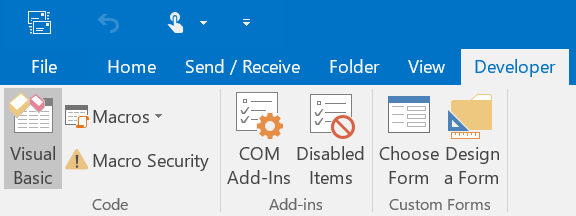
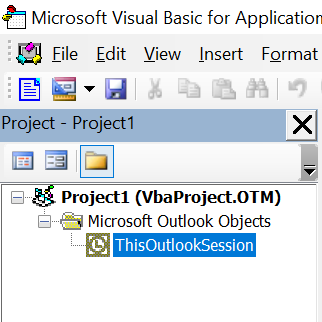
Add the following sub (Rmarkdown doesn't support formatting for VBA, so this code chunk may appear in a fairly bland format):
Private Sub Application_Reminder(ByVal Item As Object)
'This Sub will be called every time a reminder appears and will turn the '
'reminder itself into a Microsoft Object called "Item" '
'In VBA, each variable and type must be declared. '
'The email itself must be declared as a new variable of type "MailItem" '
Dim email_object As MailItem
'Before going any further, this will check that the reminder is for an '
'appointment (rather than a meeting or holiday, for example). '
If Item.MessageClass <> "IPM.Appointment" Then Exit Sub
'Similarly, if the appointment is not in the Recurring Email category that we '
'set up earlier, the sub should exit. This ensures that you can still set '
'uncategorized appointments with reminders without sending off emails '
'unintentionally. '
If Item.Categories <> "Recurring Emails" Then Exit Sub
'Now that the appointment type is confirmed to be in the correct category, we '
'can send the email itself. Using our newly created email_object, the Subject,'
'Recipients, and Attachments are pulled from the reminder object named "Item" '
'First we need to create a new email object '
Set email_object = Outlook.Application.CreateItem(olMailItem)
'Now we can draft and send! '
With email_object
.Subject = Item.Subject
.To = Item.Location
.HTMLBody = "<HTML><BODY>This is an automated email report.</BODY></HTML>"
.Attachments.Add Item.Body
.Send
End With
End Sub
And voila! Now, the stakeholders will receive a weekly email with the report attached, all without the analyst needing to lift a finger. There are, however, a few caveats worth mentioning:
- You must be logged onto your computer (this won't run automatically while away for vacation!).
- Outlook must be open, since this is where the macro is stored.
- Finally, macros must be enabled (and re-enabling must be done every time the computer is restarted).
There may be a quicker/more universal way to automate this process, but in a pinch, this allows for localized automation while keeping everything within your existing company's infrastructure!
This is a submission to the R Views Call for Documentation. For more information see rviews.rstudio.com.
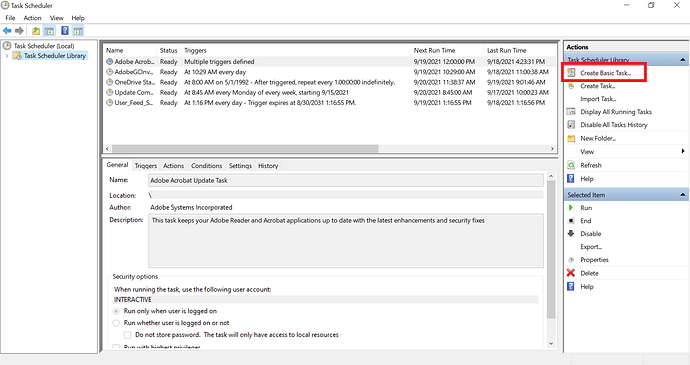
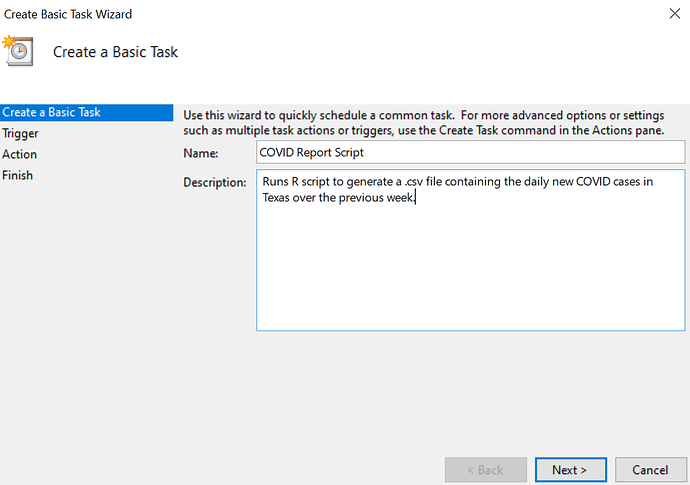
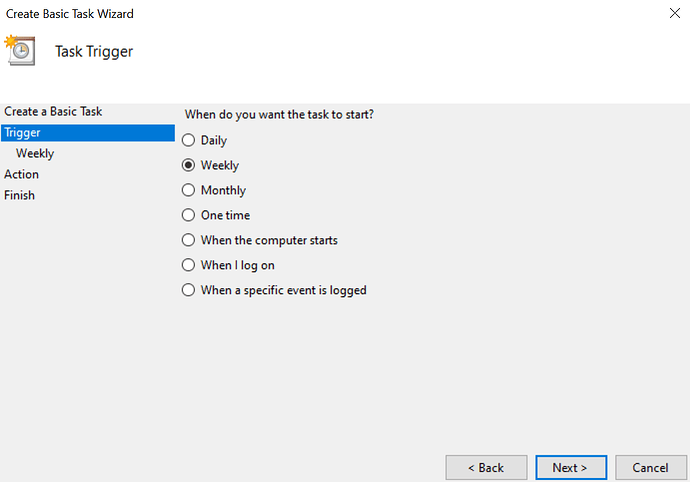
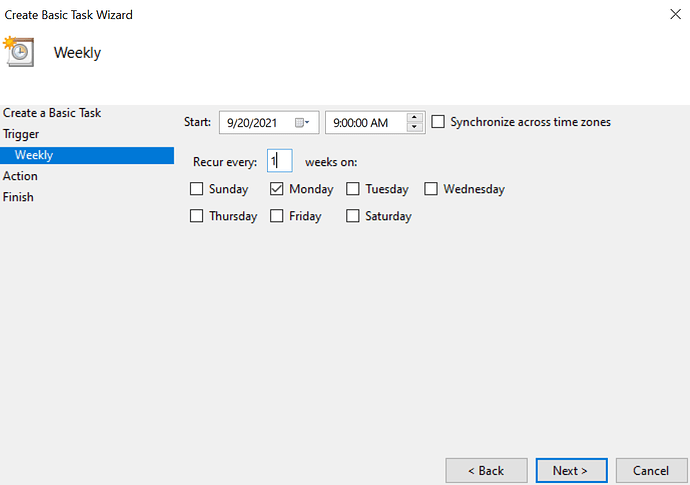
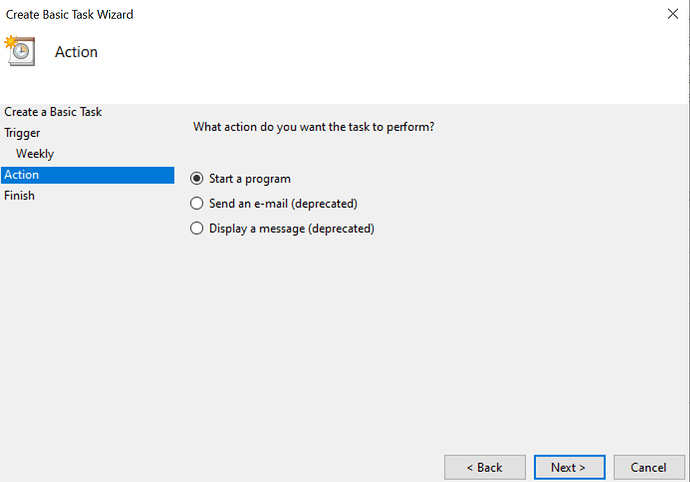
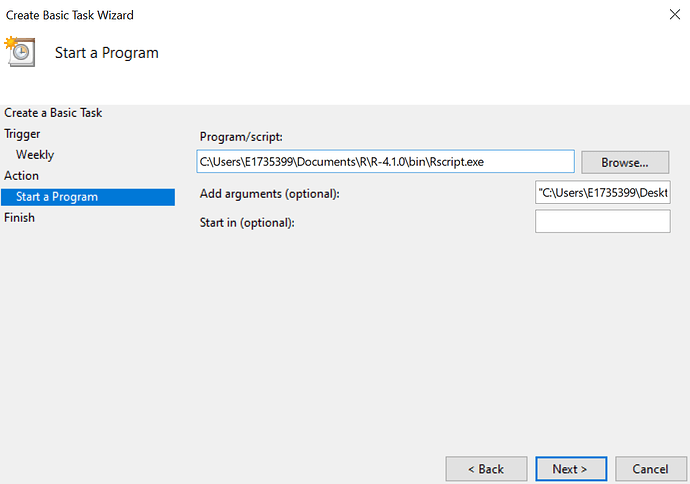
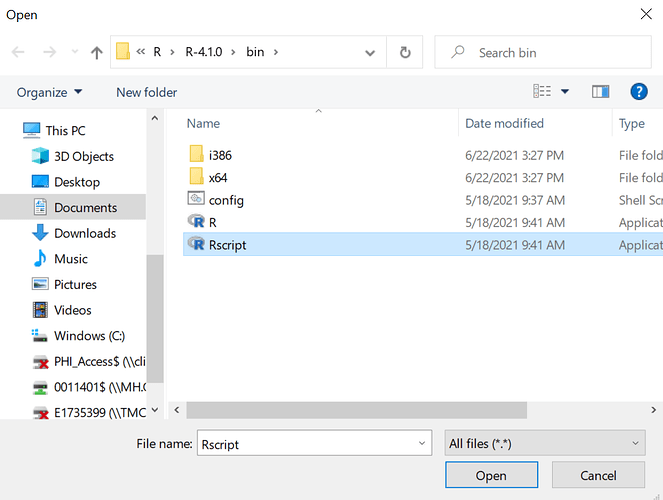

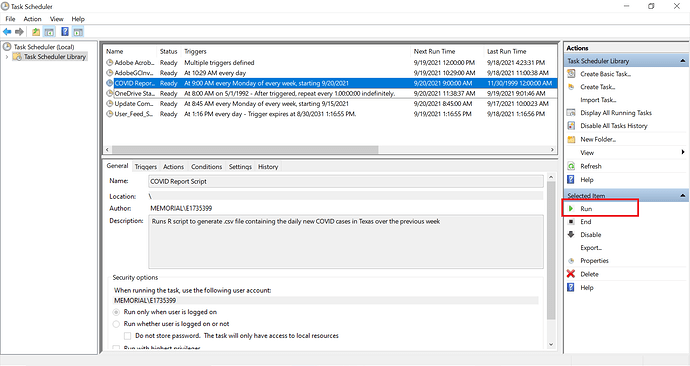

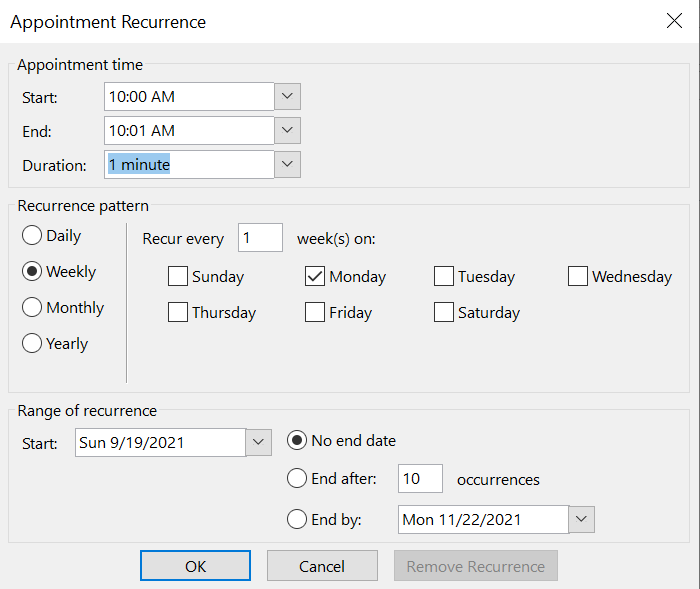
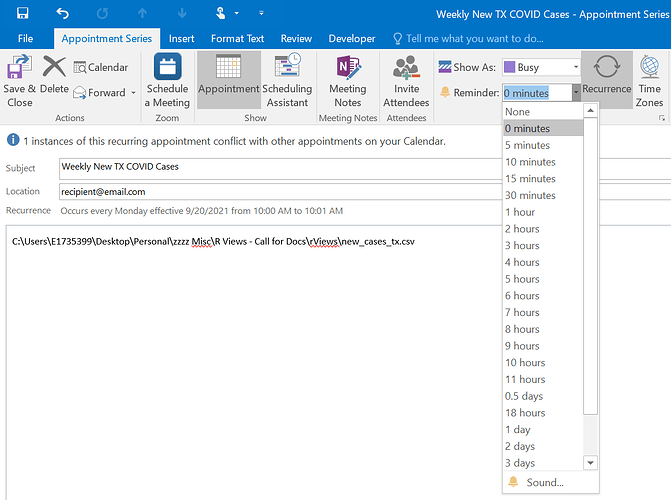

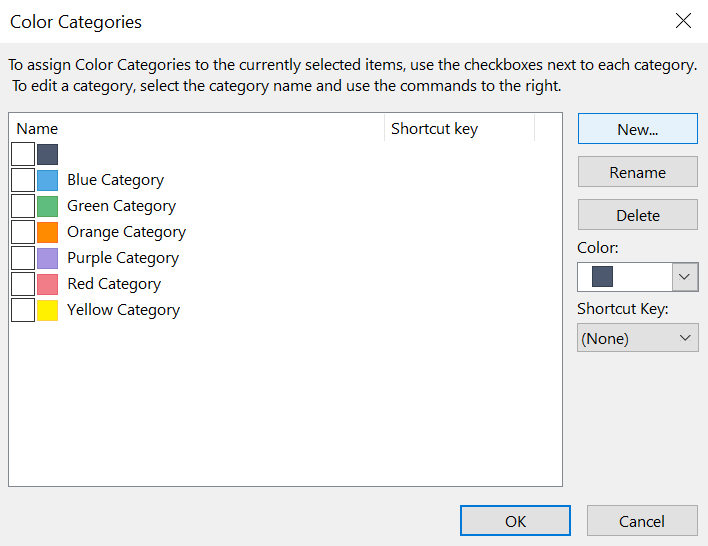
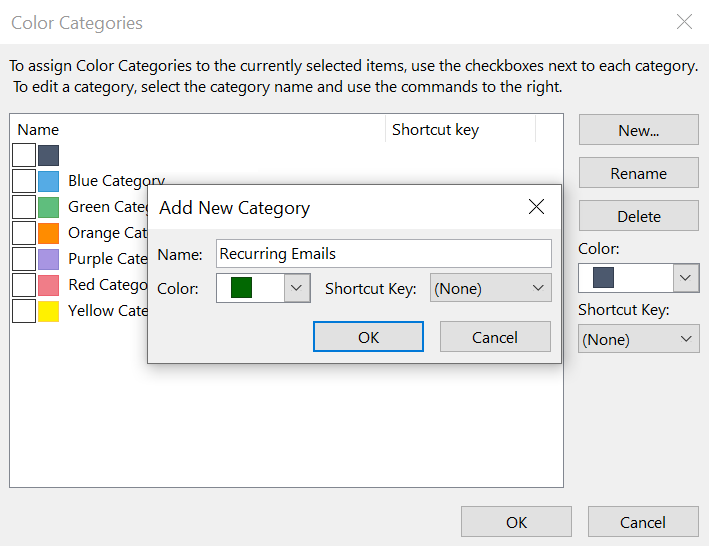
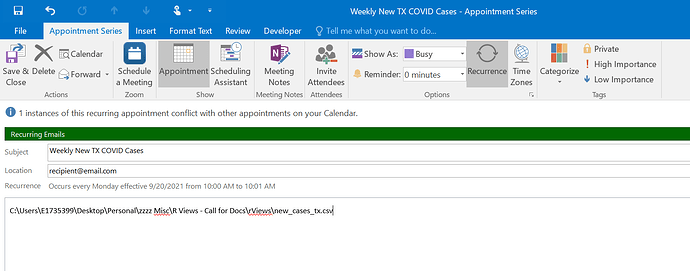
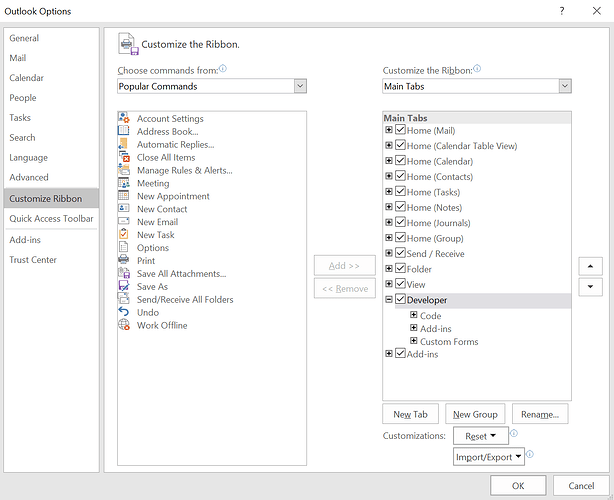
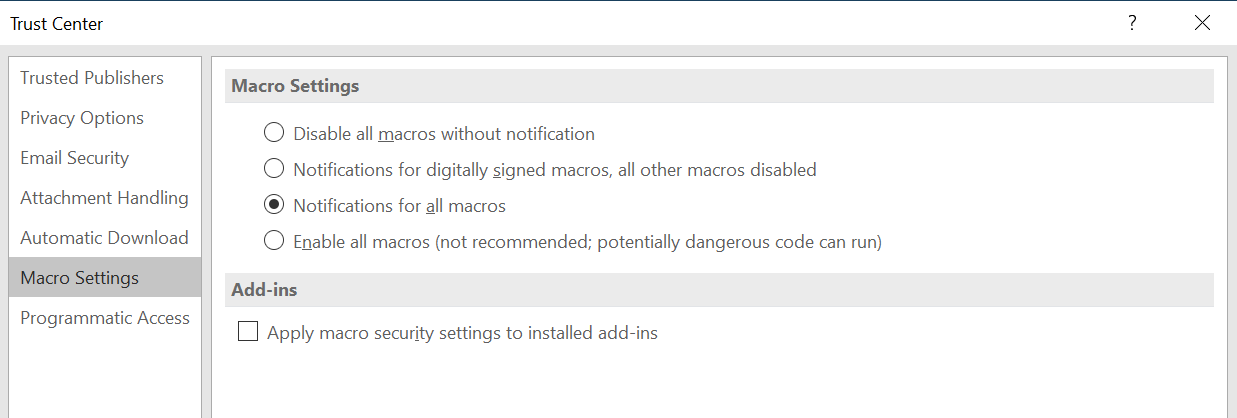
 I'll definitely give your package a look when I have a chance.
I'll definitely give your package a look when I have a chance. Excel and Outlook were primary tools in the company. As a more experience man I know now that shareable and moveable solutions are more important than even perfect solutions implemented entirely on a single person's machine
Excel and Outlook were primary tools in the company. As a more experience man I know now that shareable and moveable solutions are more important than even perfect solutions implemented entirely on a single person's machine 